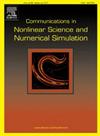Dynamics of a pituitary–adrenal model with distributed time delays
IF 3.4
2区 数学
Q1 MATHEMATICS, APPLIED
Communications in Nonlinear Science and Numerical Simulation
Pub Date : 2024-09-24
DOI:10.1016/j.cnsns.2024.108363
引用次数: 0
Abstract
This paper investigates the effects of distributed time delays on the dynamics of the pituitary–adrenal axis. Our two-dimensional model incorporates distributed time delays with general delay kernels, specifically illustrating interactions between adrenocorticotropic hormone (ACTH) and cortisol (CORT). We derive general theoretical results for general delay kernels, exemplified by Dirac and weak Gamma kernels, revealing stability transitions characterized by Hopf bifurcations. We establish conditions for the local asymptotic stability of the unique equilibrium and discuss the existence of periodic solutions. Numerical simulations demonstrate that periodic oscillations appear for appropriate values of the average time delays. Including an external input results in both ultradian and circadian rhythms, highlighting the system’s dynamic responsiveness to external stimuli.
具有分布式时间延迟的垂体-肾上腺模型的动力学特性
本文研究了分布式时间延迟对垂体-肾上腺轴动态的影响。我们的二维模型将分布式时间延迟与一般延迟核结合起来,特别说明了促肾上腺皮质激素(ACTH)和皮质醇(CORT)之间的相互作用。我们推导出一般延迟核的一般理论结果,以狄拉克核和弱伽马核为例,揭示了以霍普夫分岔为特征的稳定性转换。我们建立了唯一平衡的局部渐近稳定性条件,并讨论了周期解的存在。数值模拟证明,在平均时间延迟的适当值下会出现周期性振荡。加入外部输入会产生超昼夜节律和昼夜节律,突出了系统对外部刺激的动态响应能力。
本文章由计算机程序翻译,如有差异,请以英文原文为准。
求助全文
约1分钟内获得全文
求助全文
来源期刊

Communications in Nonlinear Science and Numerical Simulation
MATHEMATICS, APPLIED-MATHEMATICS, INTERDISCIPLINARY APPLICATIONS
CiteScore
6.80
自引率
7.70%
发文量
378
审稿时长
78 days
期刊介绍:
The journal publishes original research findings on experimental observation, mathematical modeling, theoretical analysis and numerical simulation, for more accurate description, better prediction or novel application, of nonlinear phenomena in science and engineering. It offers a venue for researchers to make rapid exchange of ideas and techniques in nonlinear science and complexity.
The submission of manuscripts with cross-disciplinary approaches in nonlinear science and complexity is particularly encouraged.
Topics of interest:
Nonlinear differential or delay equations, Lie group analysis and asymptotic methods, Discontinuous systems, Fractals, Fractional calculus and dynamics, Nonlinear effects in quantum mechanics, Nonlinear stochastic processes, Experimental nonlinear science, Time-series and signal analysis, Computational methods and simulations in nonlinear science and engineering, Control of dynamical systems, Synchronization, Lyapunov analysis, High-dimensional chaos and turbulence, Chaos in Hamiltonian systems, Integrable systems and solitons, Collective behavior in many-body systems, Biological physics and networks, Nonlinear mechanical systems, Complex systems and complexity.
No length limitation for contributions is set, but only concisely written manuscripts are published. Brief papers are published on the basis of Rapid Communications. Discussions of previously published papers are welcome.
 求助内容:
求助内容: 应助结果提醒方式:
应助结果提醒方式:


